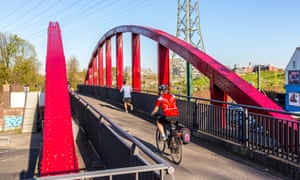reaperexpress
Senior Member
The question, then, is why engineers and road designers in this country continue to do the same thing again and again. That example I posted is among the best in Ontario; most of the rest (and there are a lot of them) are worse. If some people on a forum are aware of the Dutch examples, surely the people who write our engineering standards must be too.
They do it over and over again because other than lip service for cyclists and pedestrians, they don't really care.
I think our engineers deserve more respect than the simplistic notion that they "don't really care". But the field of traffic engineering is surprisingly insular - jurisdictions have their way of doing things, which they truly believe to be the best way and often have little interest in very different designs from elsewhere.
The fundamental issue is liability. Engineers which propose a design which is not "standard" have the duty of justifying it. If they just follow the book, then they can just say they were following "best practice". So our standard designs keep getting perpetuated even if we know there are safer designs out there.
Until recently, we didn't even have a book. But in 2013, the Ontario Traffic Manual Book 18 "Bicycle Facilities" (large pdf here) came out, written by MMM Group Consulting in collaboration with the Province and several municipalities. It basically just made up standards based on the bicycle infrastructure that had already been built in Ontario. Apparently there was consultation with Vélo Québec (the Peterborough example screams Québec to me), but I don't see any evidence of consultation with jurisdictions which have a very high safety and cycling rate such as the Netherlands. They did review the Dutch standards ("CROW"), but not much it made it in to our manual for whatever reason.
You can fairly easily spot where our designs originated before the Ontario Traffic Manual included them. The on-street cycle tracks and lanes were painted retrofits to existing roadways, while designs like the one above were just widened versions of our proven crosswalk design. There was never a comprehensive approach to determine the optimal standard designs taking into account all the characteristics of bicycles. Instead most of the on-street designs treat bicycles as narrow cars, while most of the off-street designs treat them as pedestrians with wheels.
In contrast, the Netherlands has been designing specifically for bicycles for over 40 years, and has been constantly trying new designs to see what works and what doesn't. Which means that their designs are constantly evolving, unlike ours which haven't really changed since the 1950s.
To bring proven Dutch designs here, I think the key is to get at least one example of each type built in Ontario, to prove to our engineers that what works in the Netherlands will work here too. But even then it's just a short-term fix: we'd just be playing catch up with the countries that are constantly studying and improving traffic design. I don't know how we get to the point where we are also figuring it out for ourselves.
Last edited:






